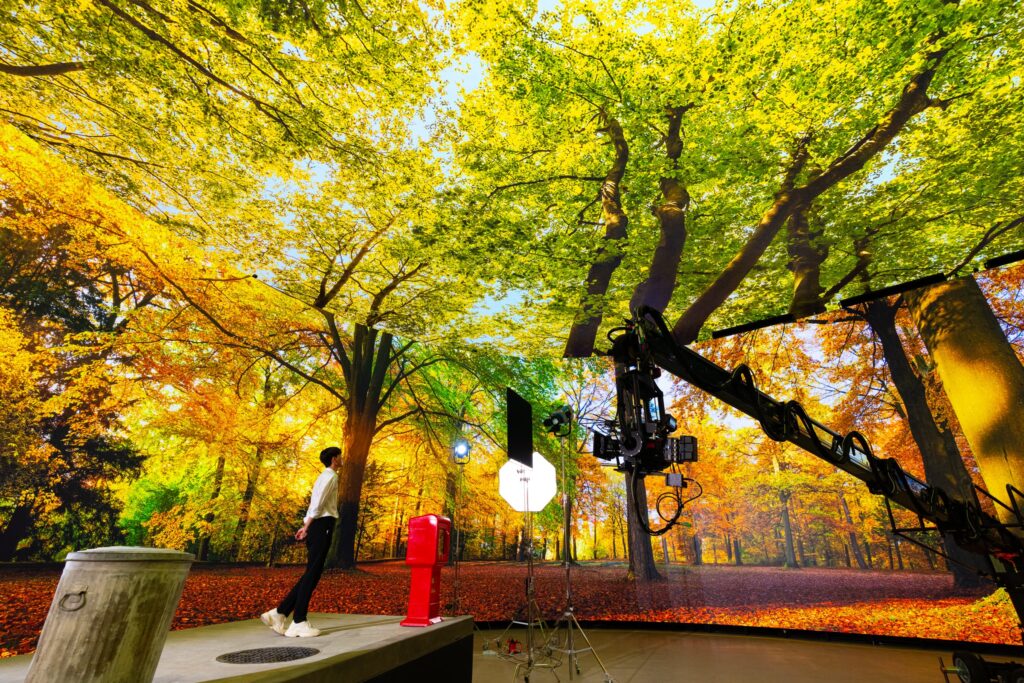At CJ ENM’s production studio center in Paju, South Korea, an actor on the set is looking around the background, the Incheon international airport bustling with hundreds of people. A second later, he is among the trees in a quiet Canadian forest full of colorful autumn leaves. The background actors in the previous scene are nowhere to be seen anymore because they were all digital images.
CJ ENM’s Paju virtual studio, which opened last May, shows how technology can transform the filming industry. It is the biggest of its kind in Korea, with a total floor area of 1650㎡.
The studio has installed advanced micro-LED displays all around its wall and ceiling. The main display is a concave LED screen that towers 7 meters high and 20 meters long. With about 400㎡-size ceiling display, it creates a seemingly endless backdrop.

Virtual Studios
CJ ENM has been working with Samsung Electronics on this project for over a year. The electronics maker supplied ‘The Wall,’ its micro-LED modular display with AI processing technology. The micro-LEDs are about 100 times smaller than conventional LEDs so that the display can project images with higher resolution for true-to-life imagery.
This is merely one example in South Korea. Many companies, from content providers to gaming giants, are getting into the on-set virtual production business. Their first step is, of course, building the studio with a giant LED display. SK Telecom recently opened Pangyo XR Studio. It has two virtual production sets. The LED display in the Volume Stage is 5 meters high and 21 meters wide, while XR Stage is 5 meters high and 5 meters wide. SK Telecom is also planning to utilize its 5G network and AI technology in the studio’s content-making process.
VA Corporation, a metaverse start-up, built three virtual studios last year in Hanam, Gyeongido. Studio C is the biggest one with a floor area of 1088㎡. This one has an LED main display 53.5m wide and 8m high.

There’s also a mega-project going on. Nexon, the most prominent game developer in Korea, is cooperating with Naver, the most famous platform company in the country. They have established a joint venture with YG Entertainment, the management agency of the popular girl group BLACKPINK. They are building ‘I-DMC(Immersive Digital Media Center).’ The I-DMC would consist of a total of five multi-studios, including a virtual production set. Nexon expects to hold multiple global events such as game showcases and e-sports competitions.
Virtual Production
Virtual production is becoming increasingly popular. It is an alternative to chroma-key production methods, also known as ‘Green Screen.’ With the Green-screen method, the actors act in front of green cloth, and computer graphic images (CGI) are added later in the compositing process. But with virtual production, the actors and directors can see the CGI in real-time.
This makes movie production faster, cheaper, and of high quality. With an LED screen as the background, there’s no need to go abroad to a foreign location. Hard-to-get-permission locations, such as famous cultural or religious spaces, can be a movie set in a second with CGI. The weather or daytime no longer restricts the filming process.
It also streamlines the production process. During the shoot, the production team can modify the scene. Take a war scene, for instance. The team can add the image of hundreds of background actors or vice versa within a moment, and the result can be viewed in real-time.

Virtual production also helps the actors to immerse themselves in the setting. Instead of green cloth, the actors can see what the actual background is when they’re acting. “Virtual production set is an optimized facility in an era where content and technology are combined.” CJ ENM spokesperson said, “It would also make a way to produce new kinds of content, such as metaverse or extended reality performances.”



